AUDI S8 2016 Owners Manual
Manufacturer: AUDI, Model Year: 2016, Model line: S8, Model: AUDI S8 2016Pages: 302, PDF Size: 75.68 MB
Page 191 of 302
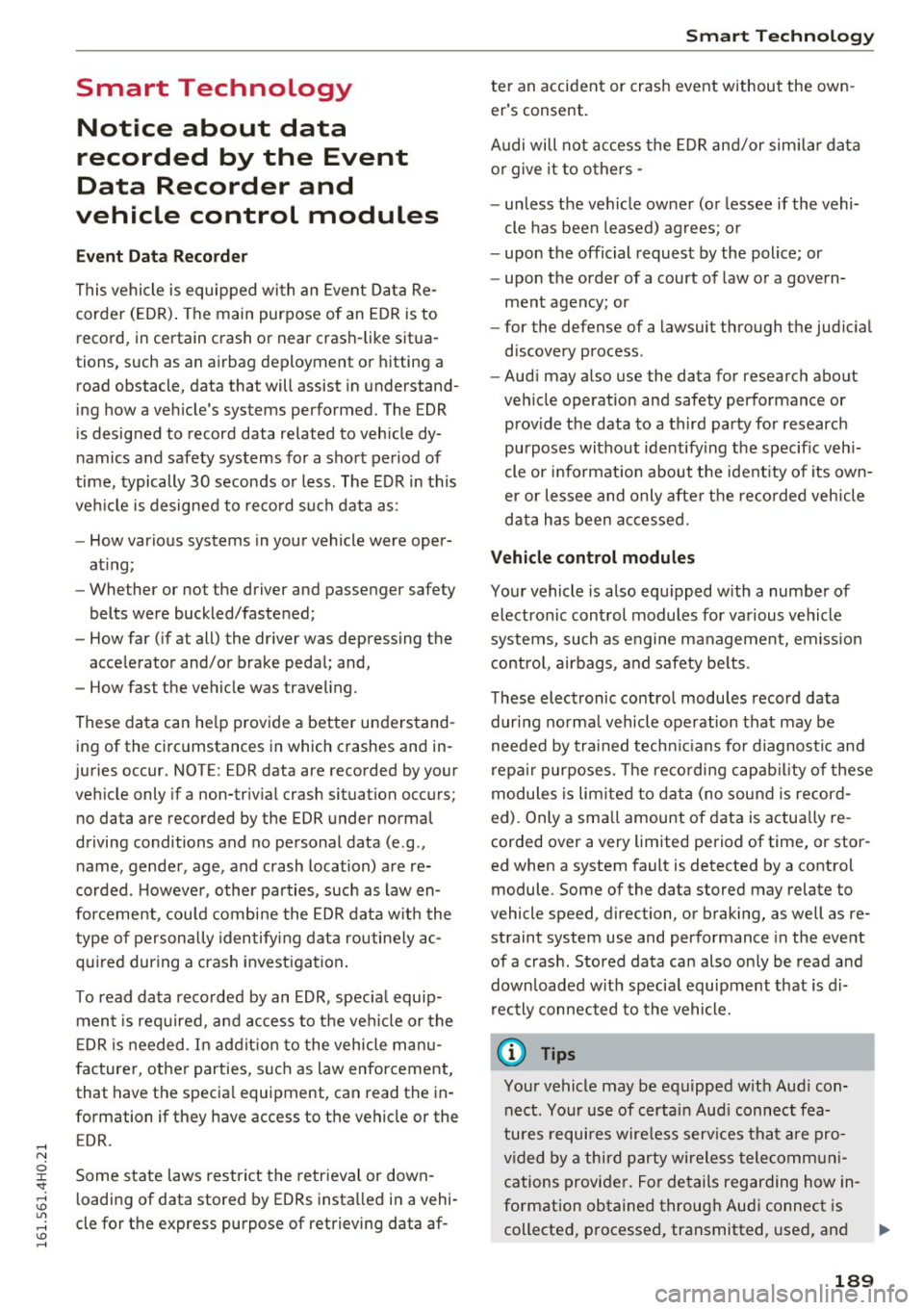
Smart Technology Notice about data
recorded by the Event
Data Recorder and
vehicle control modules
E vent Dat a Recorder
This vehicle is equipped wi th an Event Data Re
corder (EDR) . The main purpose of an EDR is to
record, in certain crash or near crash-like situa
tions, such as an a irbag deploym ent or hitting a
road obstacle, data that will assist in understand
ing how a veh icle 's systems performed . The EDR
is designed to record data related to veh icle dy
n amics and safety systems for a short period of
time, typically 30 seconds or less. The EDR in this
ve hicl e is designed to reco rd such data as :
- How various systems in your vehicle were oper
at ing;
- Whether or not the driver and passenger safety
belts were buckled/fastened;
- How far ( if at all) the dr iver was depressing the
accelerator and/or brake peda l; and,
- How fast the ve hicle was trave ling.
These data can he lp provide a better understand
ing of the c ircumstances in which crashes and in
juries occur. NOT E: EDR data are recorded by yo ur
veh icle only if a non-triv ia l crash situation occurs;
no da ta are recorded by the EDR under normal
driving conditions and no personal data (e .g .,
n ame, gender, age, and crash location) a re re
corded . H oweve r, other pa rties, such as law en
fo rcement, cou ld combi ne the EDR data w it h the
t ype of personally iden tifying dat a routine ly ac
q ui red during a crash invest iga tion .
To read data reco rded by an EDR , specia l equip
men t is req uired, a nd access to the ve hicle or the
E DR is needed. In add it ion to the vehicle man u
facturer, other parties, s uch as law enforcement,
that have the specia l equipment, can read the in
formation if they have access to the vehicle or the E DR .
Some state laws restrict the re trieval or down
l oading of data stored by ED Rs insta lled in a vehi
cle for the express purpose of retrieving data af-
Sma rt Technology
ter an accident or cras h event without the own
er 's consent.
Audi will not a ccess the EDR and/or sim ilar data
o r give it to o thers -
- unless the vehicle owne r (o r lessee if the vehi
cle has been leased) ag rees; o r
- upon the official request by the police; or
- upon the order of a court of law or a govern-
ment agency; or
- for the defense of a lawsuit through the jud ic ia l
discovery process.
- Aud i may a lso use the data for research about
veh icle operation and safety performance or
prov ide the data to a third party for research
purposes without identify ing the specific veh i
cle or info rmat io n about the ident ity of its own
er or lessee and only afte r th e re co rded veh icle
d ata has been a ccessed.
Vehicle control modules
Your vehicle is also equ ipped w ith a number of
electronic control modules for va rious vehicle
systems, such as engine ma nagement, emiss io n
contro l, airbags , and s afety be lts .
These elec tronic control modules record data
dur ing no rma l vehicle operation that may be
neede d by trained tech nicians for diagnost ic and
r e pa ir purposes. The re co rding c apab il ity of these
modules is lim ite d t o dat a (no sound is record
ed). Only a sma ll amount of data is actua lly re
corded over a very limited period of time, or stor
ed when a system fault is detected by a contro l
module . Some of the data stored may relate to
vehicle speed, direction, or braking, as well as re
straint system use and performance in the eve nt
of a crash . Stored da ta ca n also on ly be read a nd
down loaded w it h specia l equipment that is d i
r ectly connected to the vehicle.
(D Tips
Your vehicle may be equipped w ith Aud i con
nect . Your use of certai n Aud i connec t fea-
tures requi res wire less serv ices tha t are pro-
v ided by a third party wireless telecomm uni
cations provi der. For de tails regarding how in
formation obtained through Aud i connect is
collected, p rocessed, transmitted, used, and ..,.
189
Page 192 of 302
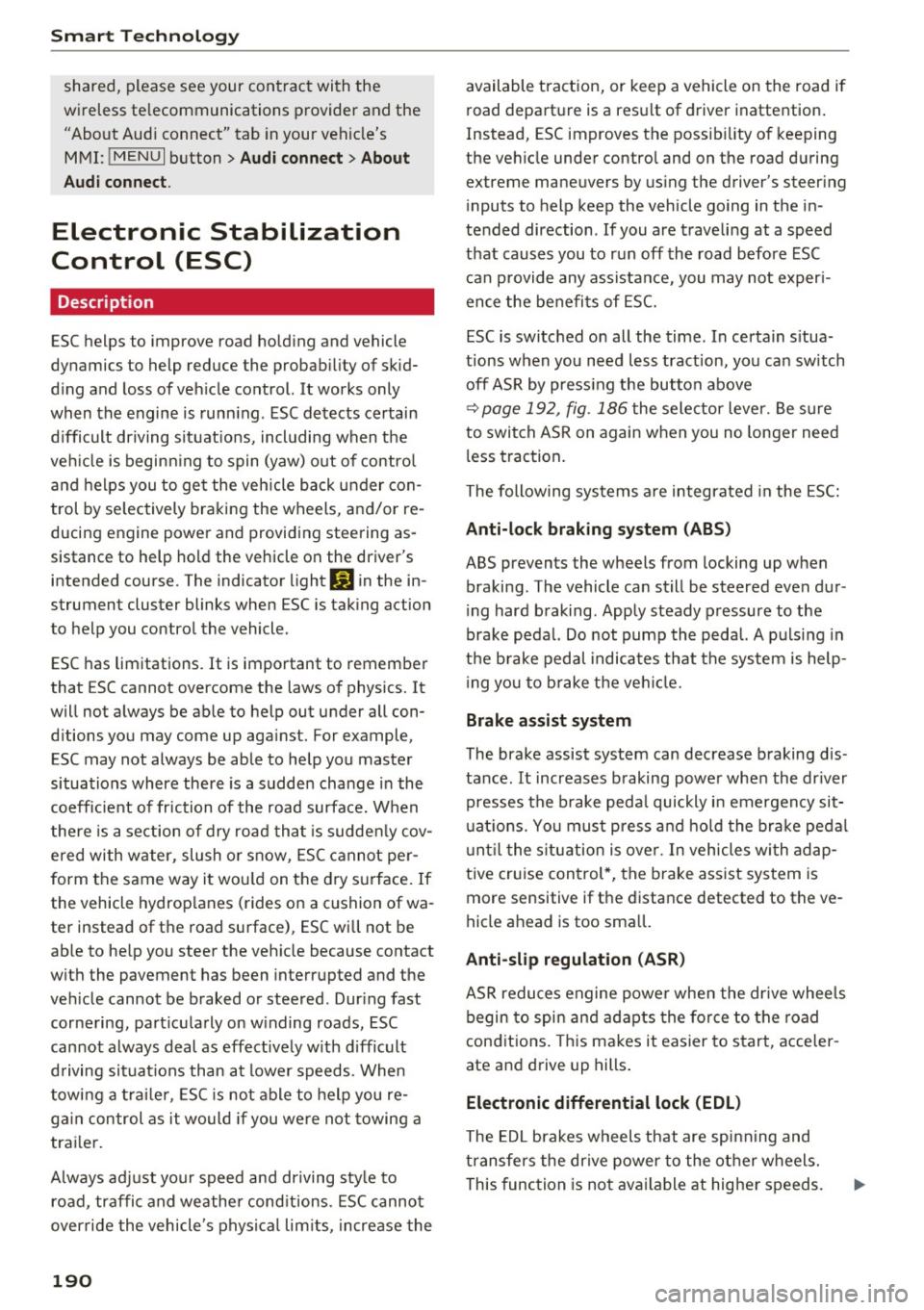
Smart Technology
shared, please see your contract with the
wireless te lecommunications provider and the
"About Audi connect" tab in your vehicle's
MMI:
! MENUI button> Audi connect> About
Audi connect.
Electronic Stabilization
Control (ESC)
Description
ESC helps to improve road holding and vehicle
dynamics to help reduce the probability of skid
ding and loss of vehicle control. It works only
when the engine is running. ESC detects certain
difficult dr iving situations, including when the
veh icle is beginn ing to spin (yaw) out of contro l
and helps you to get the vehicle back under con
trol by se lectively braking the wheels, and/or re
ducing engine power and providing steering as
sistance to help hold the vehicle on the driver's
intended course. The indicator light
GI in the in
strument cluster blinks when ESC is taking action
to help you control the vehicle.
ESC has limitations. It is important to remember
that ESC cannot overcome the laws of physics. It
will not always be able to help out under all con
ditions you may come up against . For example,
ESC may not always be able to help you master
situations where there is a sudden change in the
coefficient of friction of the road surface. When
there is a section of dry road that is suddenly cov
ered with water, slush o r snow , ESC cannot per
form the same way it wou ld on the dry surface. If
the vehicle hydrop lanes (rides on a cushion of wa
ter instead of the road surface), ESC wi ll not be
able to he lp you steer the vehicle because contact
with the pavement has been interrupted and the
vehicle cannot be braked or steered. During fast cornering, part icularly on w inding roads, ESC
cannot always deal as effective ly w ith difficult
driving situat ions than at lower speeds . When
towing a trailer, ESC is not able to help you re
ga in control as it would if you were not towing a
trai ler.
Always adjust your speed and driving sty le to
road, traffic and weather conditions. ESC cannot
override the vehicle's physical limits, increase the
190
available traction, or keep a vehicle on the road if
road departure is a result of driver inattention.
Instead, ESC improves the possib ility of keeping
the vehicle under control and on the road during extreme maneuvers by using the driver's steering
inputs to help keep the vehicle going in the in
tended direction . If you are traveling at a speed
that causes you to run off the road before ESC
can provide any assistance, you may not exper i
ence the benefits of ESC.
ESC is switched on all the time. In certa in s itua
tions when you need less traction, you can sw itch
off ASR by press ing the button above
~ page 192, fig. 186 the selector lever. Be sure
to switch ASR on again when you no longer need
l ess traction.
The following systems are integrated in the ESC:
Anti-lock braking system (ABS)
ABS prevents the wheels from locking up when
braking. The vehicle can still be steered even dur
i ng hard braking . Apply steady pressure to the
brake pedal. Do not pump the pedal. A pulsing in
the brake pedal indicates that the system is help
i ng you to brake the vehicle.
Brake assist system
The brake assist system can decrease braking dis
tance. It increases braking power when the dr iver
presses the brake pedal quickly in emergency sit
uations. You must press and hold the brake pedal
u nt il the situation is over. In vehicles with adap
tive cruise control*, the brake assist system is
more sensitive if the d ista nee detected to the ve
hicle ahead is too sma ll.
Anti-slip regulation (ASR)
ASR reduces engine powe r when the dr ive wheels
begin to spin and adapts the force to the road
cond itions. This makes it easier to start, acceler
ate and drive up hills.
Electronic differential lock (EDL)
The EDL brakes wheels that are spinning and
transfers the drive power to the other wheels.
This function is not available at higher speeds .
Page 193 of 302
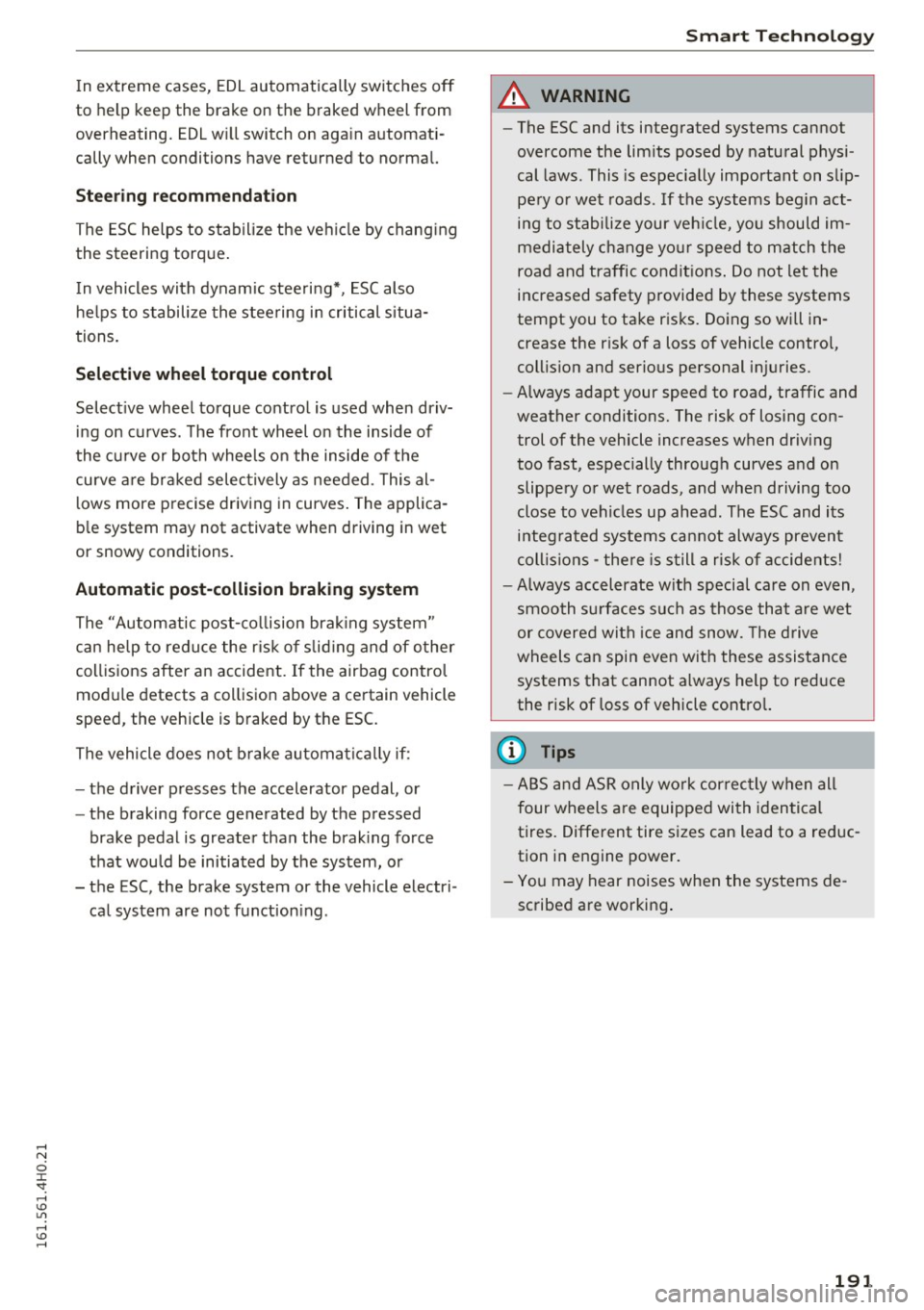
In extreme cases, EDL automatically switches off
to help keep the brake on the braked wheel from
overheating. EDL w ill switch on aga in a utomati
cally when conditions have returned to normal.
Ste ering recommendat ion
The ESC helps to stabilize the ve hicle by chang ing
the s teering torque .
I n vehicles with dynamic steering*, ESC also
h e lps to s tabilize the stee ring in critical s itua
tions.
Selective wh eel torqu e control
Select ive whee l torque control is used when driv
in g on curves . T he front wheel on the inside of
the cu rve or both wheels o n the inside of the
curve are br aked selec tively as needed . This al
l ows more precise driv ing in curves . The applica
b le system may not activate when driving in wet
or snowy conditions.
Automatic post-collision braking system
The "Automatic post-co llision bra king system"
can help to reduce the ris k of slid ing and of other
coll is ions after an accident. If the airbag contro l
module detects a col lision above a certain vehicle
speed, the vehicle is b raked by t he ESC.
The vehicle does not b rake automatica lly if :
- the driver p resses the accelerator pedal, or
- the braking force generated by the pressed
brake pedal is greate r than the brak ing force
that wou ld be initiated by the system, or
- the ESC, the brake system or the vehicle electri
ca l system are not f unction ing .
Sma rt Technology
A WARNING
- The ESC and its integrated systems cannot
overcome the limits posed by natural physi
cal laws . This is especia lly important on s lip
pe ry o r we t roads .
If the systems beg in act
i n g to stab iliz e your ve hicle, yo u should im
mediately change yo ur speed to ma tch the
road and traffic con dit ions . Do not let the
increased safety provided by these systems
tempt you to take r isks. Do ing so will in
crease the r isk of a loss of vehicle contro l,
coll is ion and serious pe rsonal in juries.
- Always adapt your speed to road, traffic and
weather conditions. The risk of losing con
trol of the vehicle increases when driving too fast, especially through curves and on
slippery or wet roads, and when driving too
close to vehi cles up ahead. The ESC and its
i n teg ra ted systems ca nnot alw ays preven t
coll is io ns -the re is s till a risk of accide nts!
- Always accelerate w ith specia l care on even,
smooth s urfaces su ch as those that are wet
or covere d wi th ice and snow. The d rive
whee ls can spin eve n wit h these assistance
systems that cannot always help to reduce
the risk of loss of vehicle contro l.
(D Tips
-ABS a nd ASR only wo rk cor rec tly when all
four wheels a re equipped wi th identi cal
tires. Diffe rent tire s izes can lead to a red uc
tion i n engine power .
- You may hear noises when the systems de
scribed are working .
191
Page 194 of 302

Smart Technology
Switching on and off
ESC turns on automatically when you start the engine.
Fig. 186 Center console w it h ESC O FF but ton
ESC level s
Sport mode on
The following situations are exceptions where it
may be useful to switch on sport mode to allow
the wheels to spin:
- Rocking the vehicle to free it when it is stuck
- Driving in deep snow or on loose ground
- Dr iving with snow chains
Sport mode off
Behavior
The ESC and ASR stabilization functions The full stabilization function of the ESC
are limited ¢
A:,.. and ASR is ava ilable again .
Operation Press the 00 button. Press
the[!] button again.
Indicator II turns on. II turns off .
lights
Driver mes- Stabilization control (ESC): Sport Warn- Stabilization control (ESC): On
sages ing! Reduced stability
A WARNING
You should only switch sport mode on if your
dr iv ing abilities and road condit ions perm it .
- The stabilization function is limited when
sport mode is sw itched on. The driving
wheels cou ld spin and the vehicle could
swerve, espec ially on s lick o r sli ppery road
s urfac es.
Sport mode cannot be sw itched on if t he
cruise cont rol system* or the adaptive cru ise
cont rol* is switched on.
Braking
What affects braking efficiency?
New brake pads
During the first 250 miles (400 km), new brake
pads do not possess the ir full braking effect, they
have to be "broken in" first ¢
.1:,.. The break-in pe
riod can be considerably longe r fo r vehicles with
192
ceramic brake rotors*. You can compensate for
this slightly reduced braking power by push ing
harder on the brake pedal. Avoid heavy braking
lo ads during the break-in period.
Operating conditions and driving habits
The brakes on today's automobiles are still sub
j ect to wear, depending large ly on operating con
ditions and driving habits¢,& . On vehicles that
are either driven mostly in stop-and-go city traf
fic or are driven hard, the brake pads should be
checked by your authorized Audi dealer more of
ten than specified in the
Warranty & Mainte
nance booklet .
Failure to have your brake pads
inspected can result in reduced brake perform
ance.
On steep slopes, you should use the brak ing ef
fect of the engine. T his way, you prevent unnec
essary wea r on the brake system. If you mus t use
your brakes, do not hold the brakes down contin-
u ously. Pump th e brakes at intervals. ..,.
Page 195 of 302

Operating noi se
Noises may occur when braki ng depend ing on the
speed, braking force and outside cond itions s uch
as temperature and humidity.
Due to the na ture of t he mate ria ls used in ce ram
ic bra ke rotors*, noises m ay become mo re appa
ren t at low speeds.
Effect of wat er and road salt
In ce rtain situat ions, for example after driving
through water, in heavy ra in, afte r ove rnig ht con
densat ion or after washing your car, the braking
effe ct can be red uced by moisture or ice on the
b rake rotors and brake pads. The brakes must be
dried first w ith a few careful brake applications .
At highe r speeds and with t he windsh ie ld wipers
turned o n, the bra ke pads p ress against the bra ke
rotors for a short amount of time . This occ urs at
regular intervals without the driver noticing and
provides for better bra ke response time under
wet conditions.
The effectiveness of the brakes can be reduced
when the vehicle is dr iven on a salt-covered road
and the brakes are not used. L ikewise, you clean
off accumu lated salt coat ing from brake discs
and pads with a few cautious applications of the
brake
c::> ,& .
Due to their sur face characteristics, ceramic
brake rotors* absorb mo isture in such condit ions.
This can cause a temporary reduction in braking
force compared to dry brakes. You can compen
sate for this by pressing the brake peda l harder.
Cor rosion
There may be a tendency for dirt to b uild up on
the brake pads and corros ion to form on the discs
if the car is not driven regularly or only for short
tr ips with little use of the brakes.
If the brakes are not used frequently, or if corro
sion has formed on the discs, it is adv isable to
clean off the pads and discs by brak ing firmly a
few t imes from a moderately high speed
c::> ,& .
Sma rt Technology
Faults in the brake system
If you s hou ld notice a sudden increase in br ake
peda l travel, then one of the two bra ke circu its
may have fai led
c::> ,& .
Low brake fluid level
Malfunctions ca n occu r in the brake system if the
brake fluid level is too low . T he brake flu id leve l
is monitored elect ronically.
Brake boost er
The brake booster works w ith vacuum pressure
wh ich is created only when the engine is runn ing
c::> ,& .
Brake lining wear status
Brake lining wear may be checked by visua l in
spect ion of the cond ition of the brake pads
t hr ough the openings in the wheel. If necessary,
the wheel may be removed for t his inspection
c::> page 259, Replacing wheels .
.8_ WARNING
-New b rake p ads don't h ave the bes t stop
p ing power an d must be "broken-in" during
the initial 250 miles (400 km) . The break-in
pe riod can be considerably longer for
veh icles with ceramic brake rotors*. You can
compensate for this by pressing the brake
pedal more firmly. This also applies late r
when new pads are installed.
- You shou ld perform braking maneuvers for
the purpose of cleaning the brake system only i f road co ndit ions pe rmit . Other road
users m ust not be put at r is k -you may
cause an ac cident!
- Before descending a steep g rade, reduce
speed and sh ift transmission into a lower
gear o r lower dr iving range. Do not r ide the
b ra kes or hold the pe dal down too long or
too often. This cou ld cause the b rakes to ge t
hot and dimin ish b raking effic iency .
- Do not " ride the bra kes" by rest ing you r foot
on the pedal when you do no t intend to
brake. This may cause the brakes to over
heat, premature wear and increased stop
p ing distance.
193
Page 196 of 302
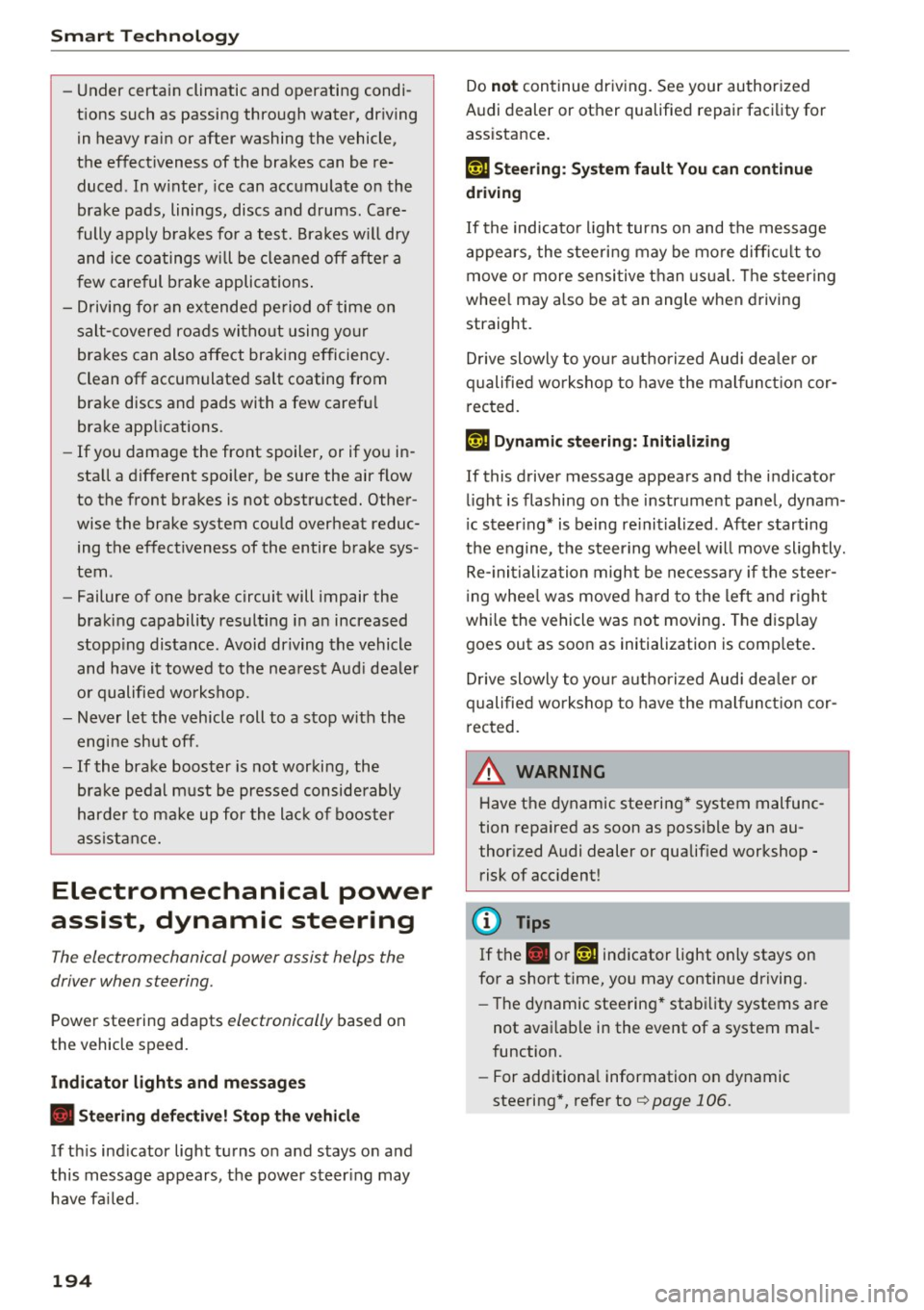
Smart Techn olo gy
- Under certain climatic and operating condi
tions such as passing through water, driving
in heavy rain or after washing the vehicle,
the effectiveness of the brakes can be re
duced . In w inter, ice can accumulate on the
brake pads, linings, discs and drums . Care
fully apply brakes fo r a tes t. Brakes w ill dry
and ice coatings wi ll be cleaned off after a
few careful brake applications .
- Driving for an extended pe riod of time on
salt-covered roads witho ut using your
brakes can also affect bra king efficiency.
Clean off accumulated salt coating from
brake discs and pads with a few carefu l
brake applications.
- If you damage the front spoiler, or if you in
stall a different spoiler, be sure the air flow
to the front brakes is not obstructed. Other
wise the brake system could overheat reduc
ing the effectiveness of the entire brake sys
tem.
- Failure of one brake circuit will impair the
braking capability result ing in an increased
stopp ing distance. Avoid driving the vehicle
and have it towed to the nea rest Aud i dealer
or qualified workshop.
- Never let the vehicle roll to a stop with the
engine shut off.
- If the brake booster is not working, the
brake pedal must be pressed considerably
harder to make up for the lac k of booster
assistance.
Electromechanical power
assist, dynamic steering
The electromechanical power assist helps the
driver when steering.
Power steering adapts electronically based on
the vehicle speed.
Ind icator light s and messages
• Stee ring defective! St op th e ve hicle
If th is ind icator light turns on and stays on and
this message appears, the power steer ing may
have fa iled.
194
Do not continue driving. See your authorized
Audi dealer or other qualified repair facility for
ass istance .
,Ion Steering : System faul t You can c ontinue
dri ving
If the indicato r light turns on and the message
appears, the steeri ng may be more diff icult to
move o r more sensitive than usu a l. T he steer ing
whee l may also be at an angle when driving
straight.
D rive slowly to your a uth orized Aud i dea ler or
qualified wo rkshop to have the malfunct ion cor
rected.
1;r,ij D ynamic steering : Init ializing
If this driver message appears and the indicator
light is flashing on the instrument panel, dynam
i c steer ing* is being re initialized . After starting
the engine, t he steering wheel w ill move slightly.
Re- initializa tion might be necessary if the steer
i ng whee l was moved hard to the left and right
while the vehicle was not moving . The display
goes out as soon as initialization is comp lete .
D rive slowly to your a uth orized Aud i dea ler or
qualified wo rkshop to have the mal func tion cor
rected.
.&_ WARNING
Have the dynamic steering * system malfunc
tion repaired as soon as possible by an au
thorized Audi dealer or qualif ied workshop -
risk of acc ident!
(D Tips
If the . or ,Ion indicator light only stays on
for a short time, you may continue driving.
- The dynamic steering* stabi lity systems are
not ava ilable in the event of a system mal
function.
- For additiona l information on dynamic
steering *, refer to~
page 106 .
Page 197 of 302
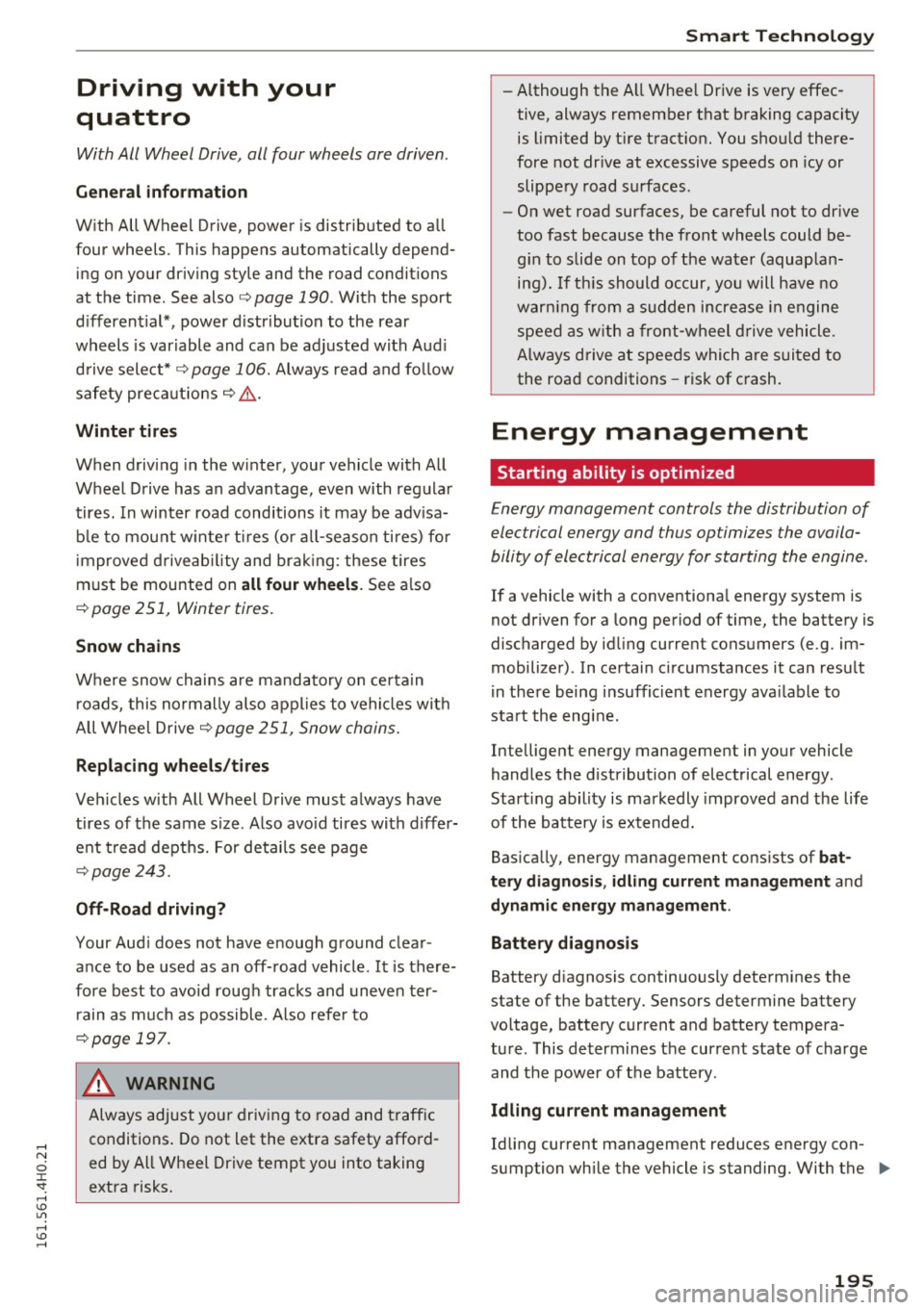
Driving with your
quattro
With All Wh eel Drive , all four wh eels are driven .
General information
With All W heel Drive, power is dis tribute d to all
four wheels . This happens automatically depend
ing on your dr iving style and the road conditions
at the time . See also¢
page 190 . With the sport
d ifferent ial*, power d istr ibution to the rear
wheels is variable and can be adjusted with Audi
d rive select*
¢ page 106. Always read and fo llow
safety preca utio ns ¢ ,&. .
Winter tires
When drivi ng in the w inter, you r vehicle with All
Wheel Drive has an advantage, even with reg ular
tires. In winter road cond itions it may be adv isa
b le to mount w inte r tir es (or a ll-season tires) for
i mproved d riveab ility and bra king : these tires
must be mounted on
all four wheels . See also
¢ page 251, W inter tires.
Snow chains
Where snow chains are mandatory on certain
roads, this normally also a pplies to vehicles w it h
All Whee l Dr ive ¢
page 251, Snow chains.
Replacing wheels /tires
Veh icles w ith All Wheel Drive must always have
tires of the same s ize. A lso avo id tires wi th d iffer
ent tread depths. For detai ls see page
¢ page 243.
Off-Road driving?
Your Aud i does not have e nough g round clear
a nce to be used as an off-road vehicle . It is there
fore best to avoid rough tracks and uneve n ter
r ain as m uch as possible . Also refe r to
¢page 197.
_& WARNING ,~ -
Always adjust you r driv ing to road and t raffic
conditions . Do not let the extra safety affo rd
ed by All Wheel Drive tempt you into taking
extra risks.
Sma rt Technology
- Although the A ll Whee l Drive is very effec
tive, always remember that braking capacity
is limited by t ire tract ion. You shou ld there
fore not dr ive at excessive speeds on icy or
slippe ry road surfaces .
- On wet road surfaces, be careful not to dr ive
too fast because the front wheels could be
g in to slide on top of the water (aquap la n
ing) . If th is should oc cur, you will have no
warn ing from a sudden increase in engine
speed as with a front-wheel d rive vehicle.
Always d rive at speeds which are suited to
the road conditions -risk of c rash.
Energy management
Starting ability is optimized
Energy management controls the distribution of
electrical energy and thus op timizes the availa
bility of electrical energy for starting the engine .
If a vehicle with a conventional energy system is
not driven for a long pe riod of time, the battery is
discharged by id ling curre nt consumers (e.g. im
mobilize r) . In certain circumstances i t can resu lt
in t he re being i nsufficien t energy ava ilable to
sta rt the engine.
Intelligent energy manageme nt in you r vehicle
hand les the distribution of electrical energy .
Start ing ability is markedly improved and the life
of the ba ttery is ex tended.
Bas ica lly, energy management cons ists of
bat
tery diagnosis , idling current management
and
dynamic energy management .
Battery diagnosis
Battery d iagnosis continuously dete rm ines the
state of the battery. Sensors determine battery
vo ltage, battery current and battery tempera
tu re. This de termines the current state o f ch arge
and the power of the battery .
Idling current management
Idling current management reduces energy con
sumption while the vehicle is standing. With the ..,_
195
Page 198 of 302
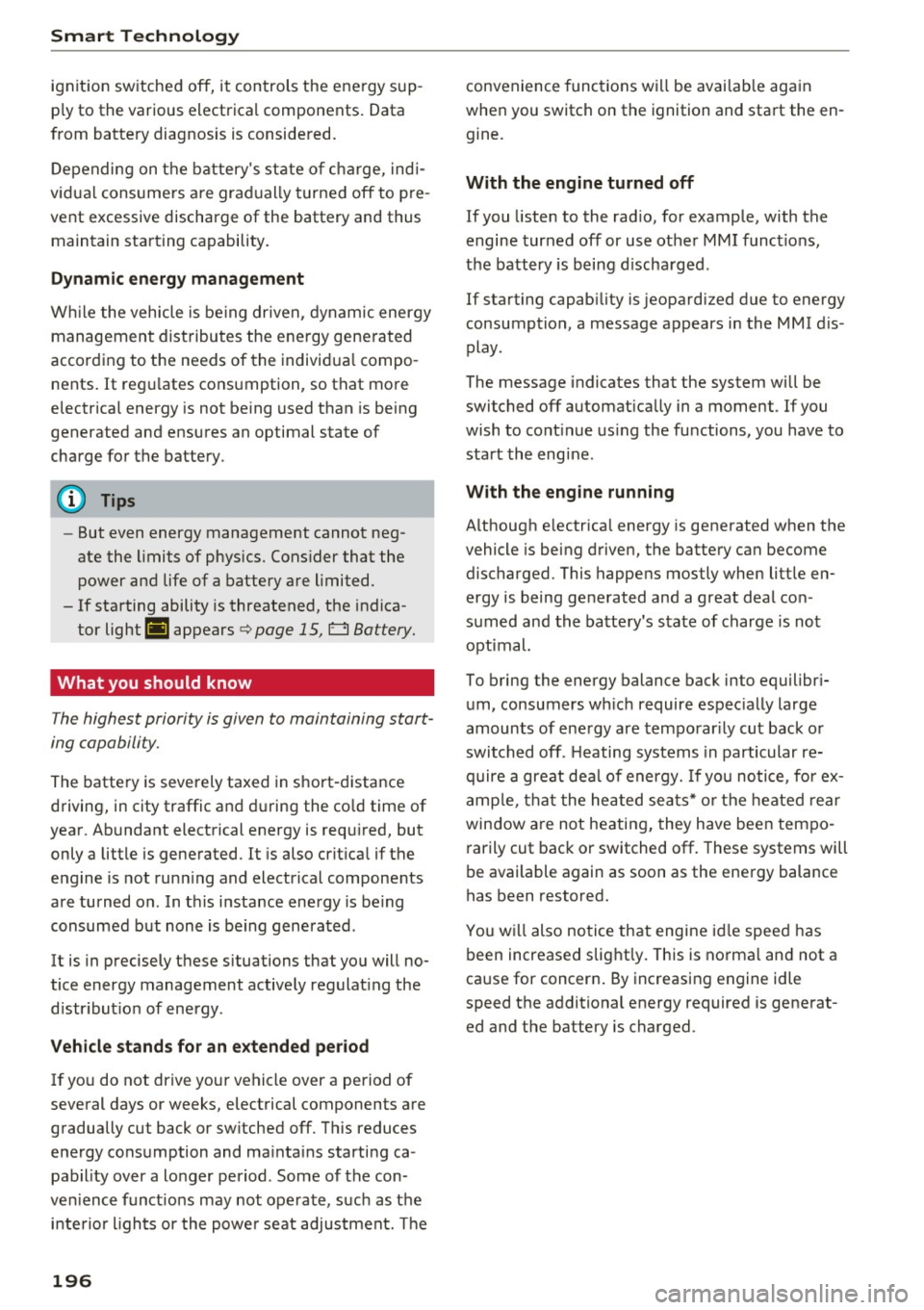
Smart Technology
ignition switched off, it controls the energy sup
p ly to the various electrical components. Data
from battery diagnosis is considered.
Depending on the battery's state of charge, indi
vidual consumers are gradually turned off to pre
vent excessive discharge of the battery and thus maintain starting capability.
Dynamic energy management
While the vehicle is being driven, dynamic energy
management distributes the energy generated
according to the needs of the individual compo
nents.
It regu lates consumption, so that more
electrical energy is not being used than is being
generated and ensures an optimal state of
charge for the battery.
(D Tips
- But even energy management cannot neg
ate the limits of physics . Cons ider that the
power and life of a battery are limited.
- If starting ability is threatened, the indica
tor light (•) appears
9 page 15, Cl Battery.
What you should know
The highest priority is given to maintaining start
ing capability .
The battery is severely taxed in short-distance
driving, in city traffic and during the cold time of
year. Abundant electrical energy is required, but
only a little is generated . It is also crit ica l if the
engine is not running and electrical components
are turned on . In this instance energy is be ing
consumed but none is being generated .
It is in precisely these situations that you will no
tice energy management actively regulat ing the
d istr ibut ion of energy .
Vehicle stands for an extended period
If you do not driv e your vehicle over a period of
several days or weeks, electrical components are
gradually cut back or switched off. This reduces
energy consumption and ma inta ins starting ca
pability over a longer period . Some of the con
ven ience funct ions may not operate, such as the
interior l ights or the power seat adjustment. The
196
convenience functions will be availab le again
when you switch on the ignition and start the en gine.
With the engine turned off
If you listen to the radio, for example, with the
engine turned off or use other MMI funct ions,
the battery is being d ischarged .
If starting capab ility is jeopardized due to energy
consumption, a message appears in the MMI dis
play .
The message indicates that the system will be
switched off automat ically in a moment . If you
wish to cont inue using the functions, you have to
start the engine.
With the engine running
Although electrica l energy is generated when the
vehicle is being driven, the battery can become
discharged. This happens mostly when little en
ergy is being generated and a great deal con
sumed and the battery's state of charge is not
opt imal.
To bring the energy balance back into equilibr i
um, consumers wh ich require espec ially large
amounts of energy are temporarily cut back or
switched off. Heating systems in particular re
quire a great dea l of energy. If you notice , fo r ex
amp le, that the heated seats* or the heated rear
window are not heating, they have been tempo
rarily cut back or switched off. These systems will
be available aga in as soon as the energy balance
has been restored.
You will also notice that engine idle speed has
been increased slig htly. This is norma l and not a
cause for concern . By increasing engine idle
speed the additional energy required is generat
ed and the battery is charged.
Page 199 of 302
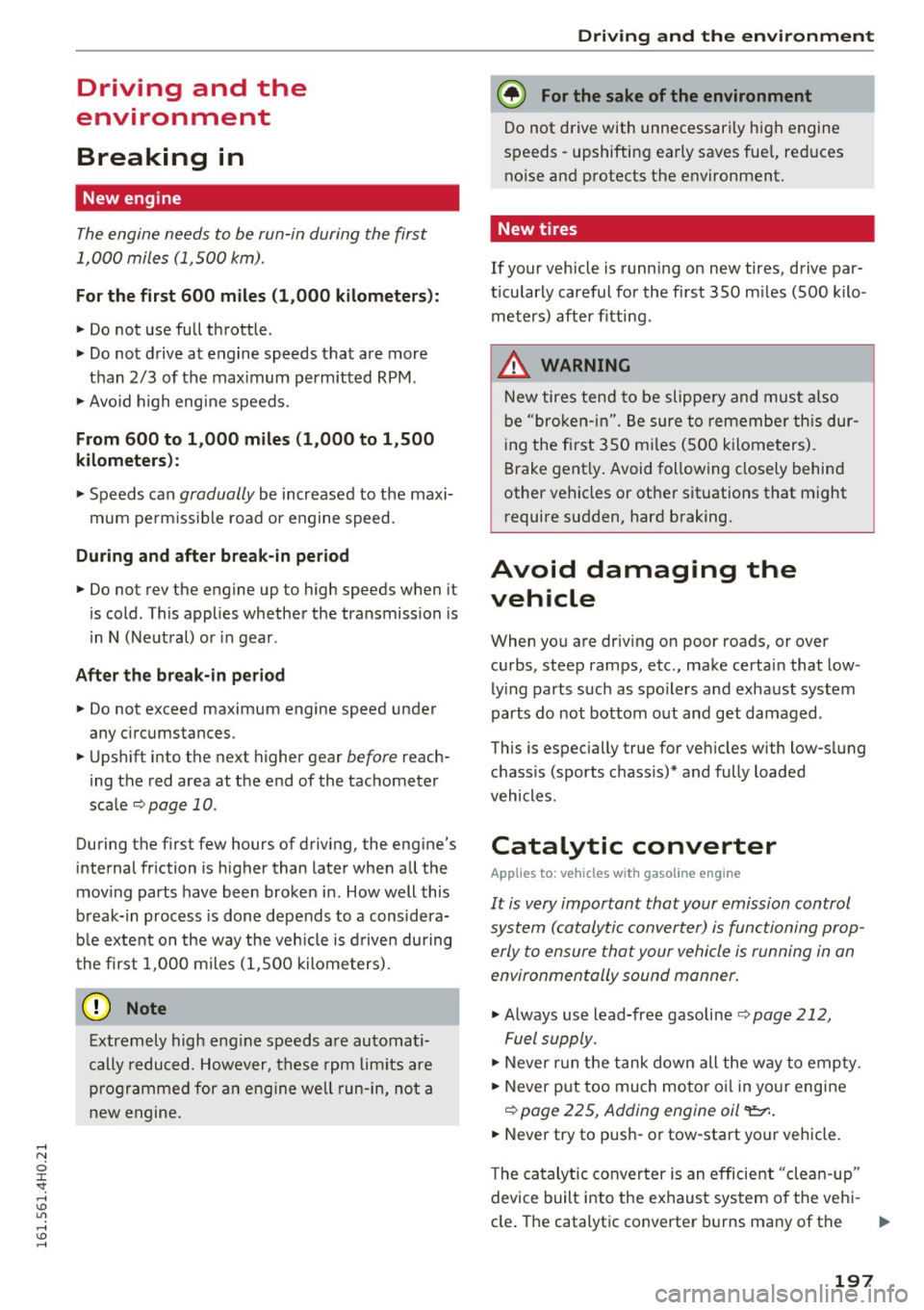
Driving and the
environment
Breaking in
New eng ine
The engine needs to be run-in during the first
1,000 miles (1 ,500 km).
For the first 600 miles (1 ,000 kilometers):
"' Do not use full throttle .
"' Do not drive at engine speeds that are more
than 2/3 of the max imum permitted RPM .
"' Avoid high eng ine speeds.
From 600 to 1 ,000 miles (1,000 to 1,500
kilometers ):
"' Speeds can gradually be increased to the maxi
mum pe rm issib le road or e ngine speed.
During and after b reak-in period
"' Do not rev the engine up to high speeds when it
is cold . This applies whether the transmission is
in N (Neutral) or in gear .
After the bre ak-in period
"' Do not exceed maximum engine speed under
any circumstances .
"' Upshift into the nex t higher gear
before reach
ing the red area at the end of the tachometer
sca le
c:::;, page 10.
During the first few hours of driving , the eng ine's
internal friction is higher than later when all the
mov ing parts have been broke n in. How well this
b reak-in process is done depends to a considera
b le exte nt o n the way the veh icle is d rive n du ring
the first 1,0 00 miles (1,500 kilome ters).
(D Note
E xtremely high eng ine speeds a re au toma ti
cally reduced. However, t hese rpm li mits are
p rogr amme d fo r an eng ine well run-in, not a
new engine .
Driving and the envir onment
{® For the sake of the environment
Do not drive with unnecessarily high engine
spe eds -upshifting early saves fuel, red uces
no ise and protects the environment.
New tires
If your vehicle is runni ng on new tires, drive par
t icularly careful for the first 3S0 m iles (500 kilo
meters) after fitting .
_&. WARNING
New tires tend to be slippe ry and mus t also
b e "bro ken- in". Be sure to remembe r th is dur
i ng the first 350 m iles ( 500 k ilome ters).
Brake gent ly . Avoid following closely behin d
other vehicles or other s ituations that might
require sudden, hard braking.
Avoid damaging the
vehicle
When you are dr iv ing on poor roads, or over
curbs, steep ramps, etc., make certai n that low
ly ing parts such as spo ile rs and exhaust system
parts do not bottom o ut and get damaged .
This is espec ially true for veh icles with low-s lung
chass is (sports c hass is)* and fully loaded
vehicles .
Catalytic converter
Applies to: vehicles with gasoline engine
It is very important that your emission control
system (catalytic converter) is functioning prop
erly to ensure that y our vehicle is running in an
environmen tally sound manner.
"' Always use lead-free gasoline c:::;, page 212,
F uel supply .
"' Never run t he tank down all the way to emp ty.
"' Never put too much motor o il in yo ur engine
c:::;, page 225, Adding engine oil ce:r..
"' Never try to push- or tow-start your vehicle.
T he ca talytic co nverter is an efficient "cle an-up"
device built into the exhaust sys tem o f th e vehi -
-
cle. The catalytic converter b urns many of the .,.
197
Page 200 of 302
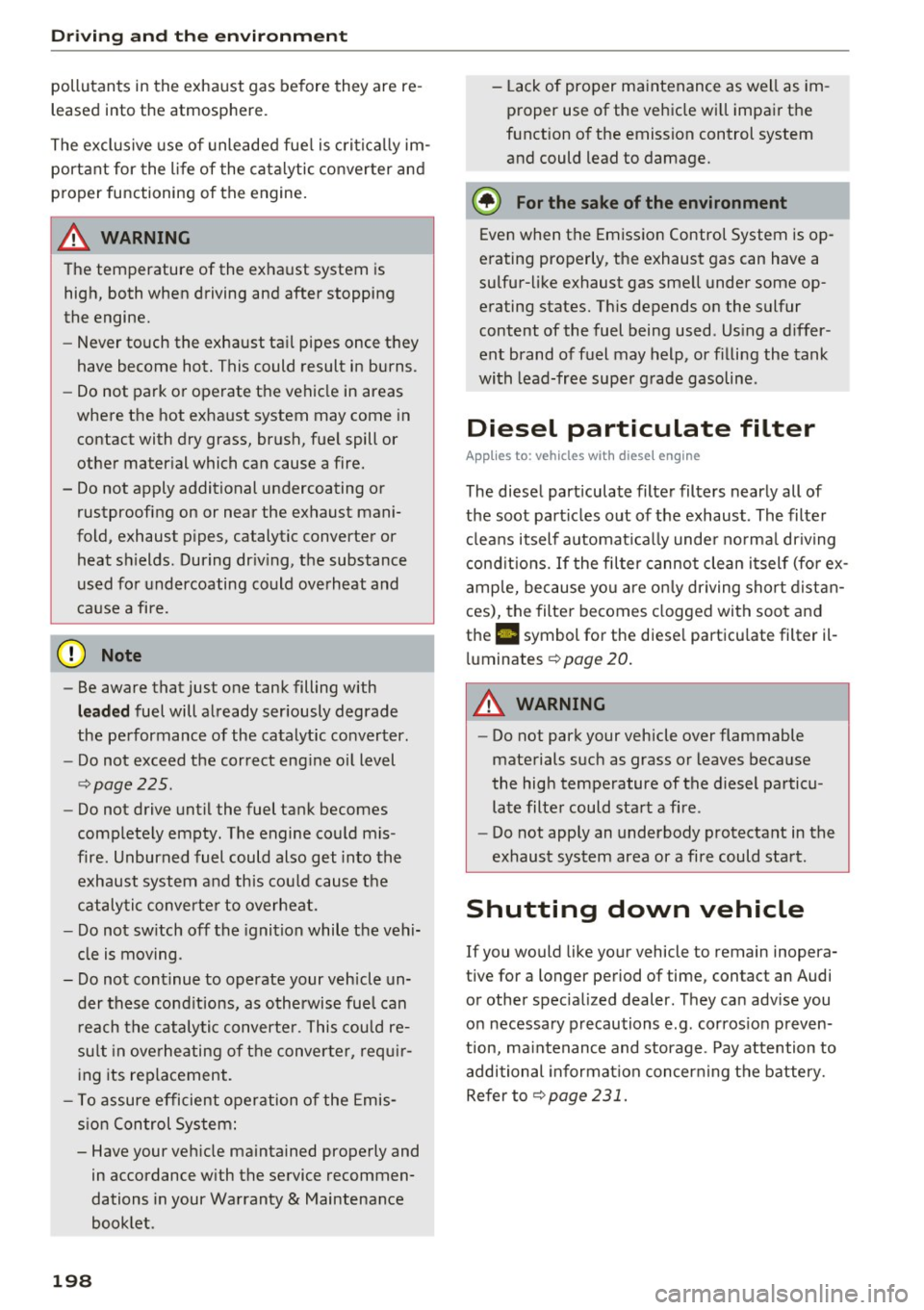
Driving and th e en vironm ent
pollutants in the exha ust gas before they are re
leased into the atmosphere.
The exclusive use of unleaded fue l is critica lly im
portant for the l ife of the catalytic converter and
proper functioning of the engine.
A WARNING
T he temperature of the exha ust system is
high, both when driving and after stopping
the engine.
-
- Never touch the exhaust tail pipes once they
have become hot. This could result in burns.
- Do not park or operate the vehicle in areas
where the hot exha ust system may come in
contact with dry grass, brush, fue l spill or
other mater ial which can cause a fire.
- Do not apply additional undercoating or rustproofing on or near the exhaust mani
fold, exhaust p ipes, catalytic converter or
heat sh ields. During dr iv ing, the substance
used fo r undercoating could overheat and
ca use a fire.
(D Note
- Be aware that just one tank filling with
le aded fuel will already ser iously degrade
the performance of the catalytic co nverter .
- Do not exceed the correct eng ine oil level
<=;> page 225.
-Do not drive until the fuel tank becomes
complete ly empty. The engine could mis
fire. Unburned fuel could also get into the
exhaust system and this cou ld cause the
cataly tic converte r to overheat.
- Do not sw itch off the ignition while the veh i
cle is moving.
- Do not continue to operate your vehicle un
der these cond it ions, as otherwise fue l can
r each the catalyti c converte r. This cou ld re
su lt in overheating of the conve rter, req uir
i ng its replacement.
- T o assure efficient oper ation of the Emis
s ion Control Sys tem:
- Have your veh icle maintained properly and
in accordance with the service recommen
dations in your Warranty
& Maintenance
book let .
198
-Lack of proper ma intenance as well as im
proper use of the vehicle wi ll impair the
funct ion o f the emission control system
and could lead to damage.
@ For the sake of the environment
Even when the Emiss ion Control System is op
erating properly, the exhaust gas can have a
su lfu r-li ke exhaust gas sme ll under some op
erating states. Th is depends on the sulfur
content of the fuel being used. Us ing a d iffer
ent brand of fuel may help, or fi lling the tank
with lead-free super g rade gasoline.
Diesel particulate filter
App lies to: vehicles with diese l engine
The diesel particulate filter filters nearly all of
the soot part icles out of the exhaus t. The filte r
clea ns itself automat ica lly unde r no rma l dr iv ing
cond it ions. If the fil ter canno t clean i tself (fo r ex
amp le, because yo u are on ly driving short distan
ces), the filter becomes clogged with soot and
the
II symbol for the diese l particu late filter il
l uminates
¢ page 20.
A WARNING
- Do not park your vehicle over flammable
materials such as grass or leaves because
the high temperature of the diesel particu
la te filte r could sta rt a fi re.
-
- Do not apply an underbody protectant in the
exhaust system area or a fire could start.
Shutting down vehicle
If you would like your vehicle to remain inopera
tive for a longer period of time, contact an Audi
or other spec ia lized dealer . They can adv ise you
o n necessary p recautions e .g. corros ion preven
tion, ma intenance and storage . Pay attention to
additional informat ion concer ning t he battery.
Refer to
<::;> page 2 31.